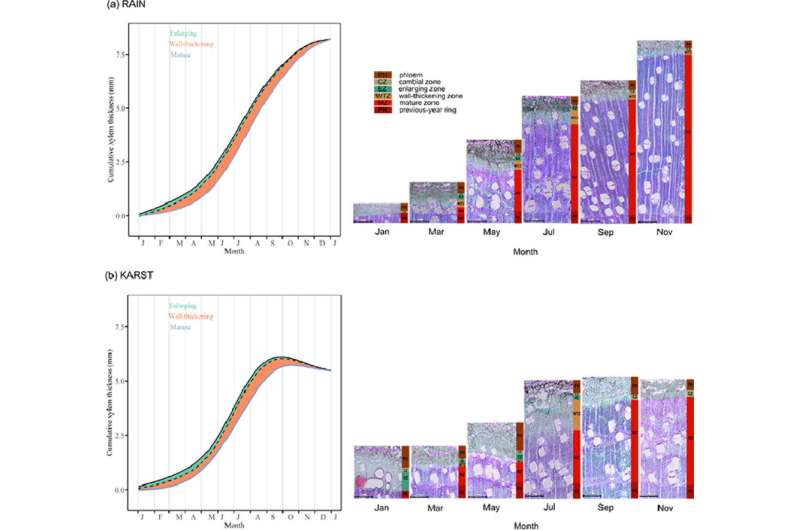Credit: Agricultural and Forest Meteorology (2022). DOI: 10.1016/j.agrformet.2022.108906
Due to the lack of clear tree-ring boundaries of most of tree species in tropical regions, investigations of tree growth and climate responses using traditional dendrochronological techniques are challenging.
In a study published in Agricultural and Forest Meteorology, researchers from the Xishuangbanna Tropical Botanical Garden (XTBG) of the Chinese Academy of Sciences provided the first estimates of the seasonal dynamics of stem radial growth and xylogenesis of Toona ciliate and their responses to environmental conditions in Asian tropical forests.
Combining high-resolution dendrometer and microcore sampling, the researchers investigated the intra-annual stem radial growth and xylem formation of T. ciliata during three consecutive years (2018–2020) in a tropical ravine rainforest and a tropical karst forest, with similar climate but contrasting soil water availability.
At different sites and years, the intra-annual growth of T. ciliate showed distinct seasonal patterns, with stem radial growth mainly occurring during March to October. The start day of stem radial growth coincided with the occurrence of cell enlarging phase, and its end day occurred concomitantly with the cessation of cell enlarging.
Compared to the ones in the drier tropical karst forest, the individuals of T. ciliata at the wetter ravine rainforest showed higher annual stem radial increment, higher growth rates, and longer durations of xylem productivity. Meanwhile, Toona ciliata at the karst forest showed higher resilience after the extreme drought events during late 2019 to early 2020 compared to the ravine rainforest.
Moreover, stem radius growth and xylem productivity of T. ciliata were mainly limited by precipitation, more so at the karst site with low soil water availability. Therefore, soil water capacity highly mediates the impact of climate and response to drought is site-specific.
"To our knowledge, this is the first study to investigate the seasonal dynamics of radial growth and xylem formation for T. ciliata, a tree species with high dendrochronological potential in tropical Asia," said Fan Zexin of XTBG.
"Our findings indicate that drought stress advances and shortens the growing season for T. ciliate," said Fan.
More information: Arisa Kaewmano et al, Climatic influences on intra-annual stem radial variations and xylem formation of Toona ciliata at two Asian tropical forest sites with contrasting soil water availability, Agricultural and Forest Meteorology (2022). DOI: 10.1016/j.agrformet.2022.108906
Journal information: Agricultural and Forest Meteorology
Provided by Chinese Academy of Sciences
























